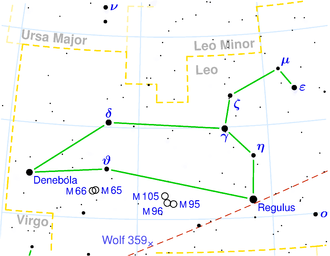NGC 3868
| Galaxie NGC 3868 | |
|---|---|
 | |
| SDSS-Aufnahme | |
| AladinLite | |
| Sternbild | Löwe |
| Position Äquinoktium: J2000.0, Epoche: J2000.0 | |
| Rektaszension | 11h 45m 29,9s[1] |
| Deklination | +19° 26′ 41″[1] |
| Erscheinungsbild | |
| Morphologischer Typ | S0[1] |
| Helligkeit (visuell) | 14,4 mag[2] |
| Helligkeit (B-Band) | 15,2 mag[2] |
| Winkelausdehnung | 0,8′ × 0,3′[2] |
| Positionswinkel | 85°[2] |
| Flächenhelligkeit | 12,7 mag/arcmin²[2] |
| Physikalische Daten | |
| Zugehörigkeit | Abell 1367 |
| Rotverschiebung | 0.021351 ±0.000043[1] |
| Radialgeschwindigkeit | (6401 ±13) km/s[1] |
| Hubbledistanz vrad / H0 | (284 ± 20) · 106 Lj (87,0 ± 6,1) Mpc [1] |
| Geschichte | |
| Entdeckung | Edouard Stephan |
| Entdeckungsdatum | 23. März 1884 |
| Katalogbezeichnungen | |
| NGC 3868 • PGC 36638 • CGCG 097-135 • MCG +03-30-104 • 2MASX J11452991+1926407 • LDCE 836 NED040 | |
NGC 3868 ist eine linsenförmige Galaxie vom Hubble-Typ S0 im Sternbild Löwe an der Ekliptik. Sie ist schätzungsweise 284 Millionen Lichtjahre von der Milchstraße entfernt, hat einen Durchmesser von etwa 65.000 Lj und ist ein Mitglied des Leo-Galaxienhaufens Abell 1367.
Im selben Himmelsareal befinden sich u. a. die Galaxien NGC 3857, NGC 3859, NGC 3864, NGC 3867.
Das Objekt wurde am 23. März 1884 von Edouard Stephan entdeckt.[3]
Weblinks
Einzelnachweise
Auf dieser Seite verwendete Medien
Autor/Urheber: Copyright © 2003 Torsten Bronger., Lizenz: CC BY-SA 3.0
This is a celestial map of the constellation Leo, the Lion.
Autor/Urheber: Sloan Digital Sky Survey, Lizenz: CC BY 4.0
The sky image is obtained by Sloan Digital Sky Survey, DR14 with SciServer.
Angle of view: 4' × 4' (0.3" per pixel), north is up.
Details on the image processing pipeline: https://www.sdss.org/dr14/imaging/jpg-images-on-skyserver/



